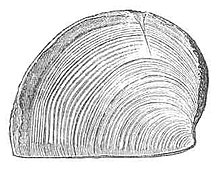
Back Aptychy Czech Aptychus German Apticus Spanish Aptychus French Áptico Galician Aptychus Hungarian
This article includes a list of general references, but it lacks sufficient corresponding inline citations. (November 2013) |


An aptychus is a type of marine fossil. It is a hard anatomical structure, a sort of curved shelly plate, now understood to be part of the body of an ammonite. Paired aptychi have, on rare occasions, been found at or within the aperture of ammonite shells. The aptychus was usually composed of calcite, whereas the ammonite shell was aragonite.
Aptychi can be found well-preserved as fossils, but usually quite separate from ammonite shells. This circumstance led to them being initially classified as valves of bivalves (clams), which they do somewhat resemble. Aptychi are found in rocks from the Devonian period through to those of the Cretaceous period.[1]
There are many forms of aptychus, varying in shape and in the sculpture of the inner and outer surfaces. However, because they are so rarely found in position within the ammonite shell, it is often unclear which kind of aptychus belonged to which species of ammonite.
When only a single plate is present, as is sometimes the case, the term "anaptychus" is used.
- ^ Zell, P., Stinnesbeck, W., Beckmann, S. (2016). "Late Jurassic aptychi from the La Caja Formation of northeastern Mexico". Boletín de la Sociedad Geológica Mexicana. 68 (3): 515–536. doi:10.18268/BSGM2016v68n3a8.
{{cite journal}}: CS1 maint: multiple names: authors list (link)
© MMXXIII Rich X Search. We shall prevail. All rights reserved. Rich X Search